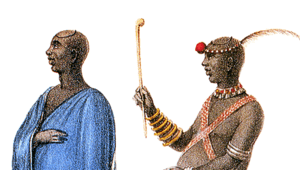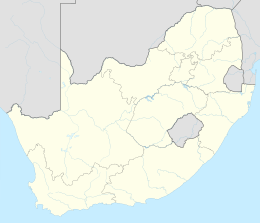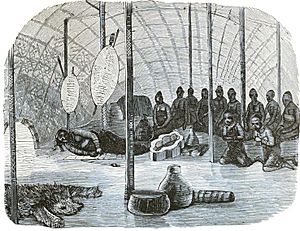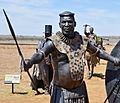Dingane kaSenzangakhona facts for kids
Quick facts for kids Dingane ka Senzangakhona |
|
|---|---|
| King of the Zulu Kingdom | |

Dingane in ordinary and dancing dress
|
|
| Reign | 1828–1840 |
| Coronation | 1828 |
| Predecessor | Shaka |
| Successor | Mpande |
| Born | 1795 |
| Died | 1840 Eswatini |
| Spouse | several wives |
| Issue | none surviving |
| Father | Senzangakhona kaJama |
Dingane ka Senzangakhona Zulu (around 1795-1840) was a powerful Zulu chief. He became the king of the Zulu Kingdom in 1828. Dingane built his main royal city, called uMgungundlovu, in a valley near the White Umfolozi River. This city was also a large military camp.
Contents
Becoming King
Dingane became king in 1828. He took over after his half-brother, Shaka, passed away. Dingane was helped by another brother, Umhlangana, and Shaka's bodyguard, Mbopa. People often say they acted because Shaka had become very harsh after his mother Nandi died. This event happened in the area known today as Stanger.
Dingane's Royal City: uMgungundlovu
Dingane built his capital city, umGungundlovu, in 1829. He made it even bigger five years later. UmGungundlovu was set up like a typical Zulu military camp, called an ikhanda.
The ikhanda had a large, round open area in the middle. This was used for parades and gatherings. Around this open space were huts for warriors and places to store their shields.
The king's special living area, called the isigodlo, was on the south side. It was directly across from the main entrance. The king and many people from his royal court lived here. There were at least 500 people, including many women who served the king. These women were divided into two main groups. One group, the "black isigodlo", included about 100 special women. A smaller group within them, called the bheje, were favored by the king.
The other group of women was called the "white isigodlo". These were mostly girls given to the king by important leaders. He also chose other girls during the yearly umkhosi wokweshwama ceremony.
A large, half-moon shaped area was part of the "black isigodlo". Here, the women and the king would sing and dance. The huts in this area were divided into small sections, each with about three huts. These sections were separated by tall hedges, creating a maze of paths.
The king's private hut, called an ilawu, was in one of these sections. It was very large and kept extremely tidy by his attendants. It could easily hold 50 people. Recent studies by archaeologists show that the floor of this hut was about 10 meters wide. They found signs that 22 large support posts inside the hut were covered in glass beads. Visitors like Piet Retief and missionaries Champion and Owen had also written about these beads.
Challenges to His Rule
Dingane did not have the same strong military and leadership skills as Shaka. Because of this, some chiefs decided to break away from his rule. This problem became worse when new settlers, known as the Voortrekkers, arrived and caused armed conflicts.
Fighting the Voortrekkers
In November 1837, Dingane met with Piet Retief. Retief was a leader of the Voortrekkers. Dingane agreed to give land to the Voortrekkers if they helped him get back some stolen cattle. He signed a document about this land transfer. It is thought that Dingane understood what he was signing. However, he likely did not understand the idea of owning land permanently. This was not a custom among the Zulu people.
On February 6, 1838, after two days of celebrations, King Dingane ordered Retief and his group to be killed. They had been told to leave their guns outside the royal camp. Suddenly, during a lively dance, King Dingane shouted, Bambani aba thakathi! (Catch the wizards!). Retief and his men were quickly captured. They were taken to a hill called kwaMatiwane and killed. Some people say they were killed because they kept some cattle that were recovered. Most people believe Dingane did not want to give up the land and did not trust the Voortrekkers.
At the same time, Dingane's army attacked Retief's unarmed group of settlers. About 500 people, including men, women, and children, were killed. The Voortrekkers called this event the Weenen massacre. The nearby town of Weenen (which means "weeping" in Dutch) was named to remember this sad event.
Dingane then ordered his army to find and kill another group of Voortrekkers led by Andries Pretorius. The Zulu army attacked their camp. However, they were badly defeated in the Battle of Blood River. About 3,000 Zulu warriors were killed, while only three Voortrekkers were slightly hurt. Dingane's commander in this battle was Ndlela kaSompisi.
His Downfall and Death
In January 1840, Pretorius and 400 Boers helped Mpande rebel against Dingane. Mpande was Dingane's half-brother. This led to Dingane being overthrown and eventually dying. During the Battle of Maqongqo, many of Dingane's own soldiers joined Mpande's army.
Dingane had his general, Ndlela kaSompisi, executed. With only a few followers, Dingane fled to the Lubombo mountains in Nayawo territory. A group of Nyawo and Swazi people assassinated him in Hlatikhulu Forest.
Mpande became the new king, succeeding his half-brother Dingane. Dingane's grave is located near Ingwavuma in the Hlatikulu Forest.
Images for kids
-
Bronze statue of Dingane at Maropeng, in the Long March to Freedom exhibition
See also
 In Spanish: Dingane kaSenzangakhona para niños
In Spanish: Dingane kaSenzangakhona para niños







